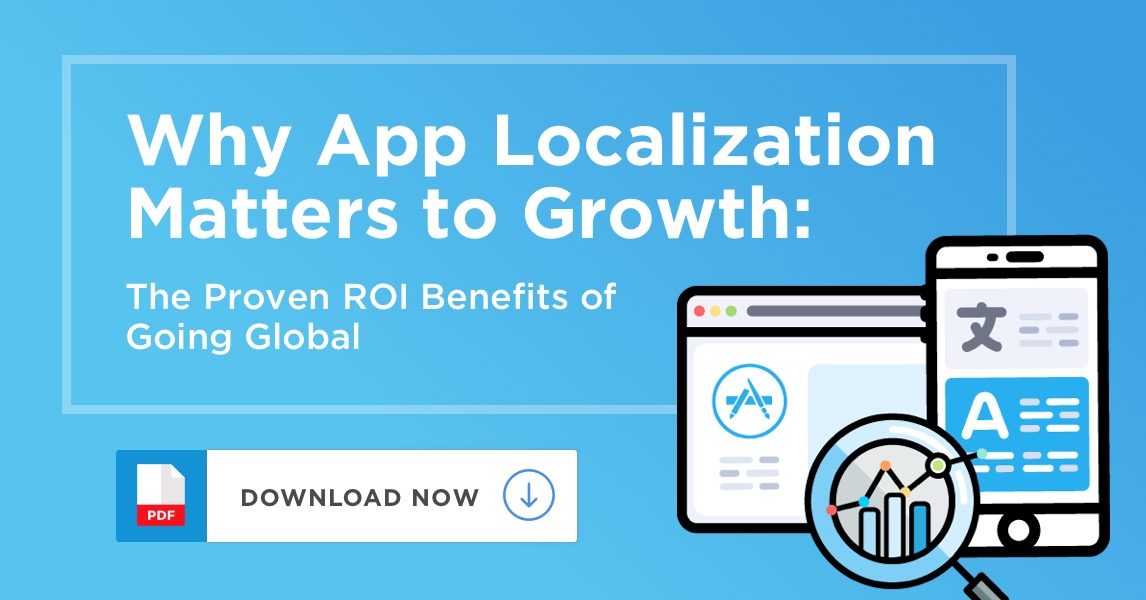Trying to Drive Growth? Why App Localization Makes Sense
Why localization should be part of your growth strategy
It’s Q1 of 2015. You’re still looking for ways to drive growth in the quarters ahead. Maybe a marketing campaign? Something else?
Andy Carvell, Soundcloud’s mobile growth manager, shared his recipe for growth in a recent post on Medium. Carvell lays out a mobile growth strategy, with a wide range of ideas. High on his list? Going international. Carvell describes internationalization as a multiplier strategy because it “will act as a catalyst for your acquisition, engagement and monetization efforts,” with effects “across the board.”
In short: going global offers huge potential for mobile apps. In this post, we’ll show you how—and why—to make app localization part of your growth strategy.
1. With just two additional languages, you’ll reach more than half the global market.
According to App Annie’s 2014 retrospective, the United States, Japan, and South Korea are the three biggest app markets in the world. Together, they generate more revenue than every other country in the world combined.
The equation is simple: if your app is already in English, and then you develop a version for the Japanese and Korean markets, you’ll have access to more than half the global market.
Smartphone users in Japan and Korea are big spenders. But English proficiency is low in both countries, and users show a strong preference for localized apps. To succeed there, you’ll have to localize, too.
2. Localization can help you get featured on the App Store.
App developers tend to forget it, but the App Store is a global distribution channel. It’s available in 150 countries and supports 40 different languages.
Apple has made its priorities clear: internationalization matters to them. Apple has local teams that curate great iOS apps in their given regions, and then feature them in their respective App Stores. Those teams aren’t just looking for great apps. They’re looking for content that fits the local market well.
Localizing your app will increase the chance that the App Store will feature it. For an example, look at Carrots, a productivity app made by the Hong Kong startup Innopage. Since localizing into six languages, Carrots has been featured in the App Store and seen an 800% boost in downloads. As Keith Li, the CEO of Innopage, explains, “I will imagine that for us, as a very small team based out of Hong Kong, it wouldn’t be possible to get featured worldwide unless we do all those translations.”
To learn more about how localization can boost your chances of having an app featured by the App Store, check out this blog post.
3. Localization requires some tweaks in your code, but they’re small—and they last.
To prepare your code for localization, your engineering team will need to extract text strings from the code. String extraction isolates text from the source code and makes its available for translators.
The process can be inconvenient. The good news is that, once it’s done, it’s done: your extracted strings can be used for one translation or twenty, now or in the future.
As a result, the savviest app developers prepare for localization early in the development process. That way, they’re ready to localize whenever and wherever they need to in the future. “Do at least two languages early on, so that when it’s time for localization most of the architecture is already in place,” suggests Matthieu Rouif, a senior software engineer working on Replay, the popular video-taking app.
4. Localization is scalable
Localization has the reputation of being a bulky, all-or-nothing endeavor. That’s not true. Nowadays, localization is scalable. You can start small—by localizing your app store listing, for example—and then work your way up to a full-blown localization campaign.
Basically, there are three levels of scalability. The most basic level is app store localization. The second level is full localization of your app’s text and audiovisual content. The final level is culturalization, in which you customize features (such as graphics) to fit the preferences of different markets.
5. Localization is agile
Localization doesn’t need to be separate from other parts of the development process. With the use of API, you can integrate localization work directly into other updates and innovations, on an as-needed basis.
Whenever you update content, send those updates to a translation platform via API on demand, and notify your translators that work is waiting for them. Bam! You’ll be able to implement translations seamlessly and immediately into your app.
6. A translation management system will make localization so much easier.
If you’re feeling ready to go global, take our advice: localization is way easier with a good translation management system (TMS). A TMS keeps all your translated content organized, and it creates a centralized space where engineers, translators, and project overseers can collaborate on the work. Especially as you expand to more and more markets, a TMS will be essential for keeping the translation process efficient, organized, and painless.
7. Give localization a priority
Localization isn’t hard. But it requires the consistent commitment of a lot of players, including the engineering team, who will have to prepare code for localization and deal with any bugs that may arise. You want to make sure that everyone’s on board: they need to understand what localization is, and why it matters to your app’s growth.
The good news is that localization is fun. You’re launching a global campaign! You’re taking your ideas to new shores! It’s not a hard sell.
Your Turn
Want to learn more about the ways that localization is essential to growth? Read our free data report, “Why Localization Is Essential To Growth” to learn more about why and how you should be localizing for your app genre:
 hbspt.cta.load(1761271, ’19fa3b82-e538-422d-b610-3327d727d90e’, {});
hbspt.cta.load(1761271, ’19fa3b82-e538-422d-b610-3327d727d90e’, {});
Don’t miss out on localization resources and tips! Subscribe to our newsletter to learn the best ways to go global.



 Written by -
Written by - 




 Written by
Written by 



Great insights on app localization! As a tech company, we’ve seen firsthand how adapting content to different languages and cultural nuances significantly boosts user engagement and retention. Beyond just translation, elements like local payment options, region-specific marketing, and UX adjustments make a huge difference in global expansion. Thanks for shedding light on this crucial aspect of app growth!